Mike Bartick: Slugfest
Mike Bartick: Slugfest
Introduction
Charismatic, colorful and slow. What better combination of features could anyone ask for in a subject when it comes to underwater photography? This combination of ingredients is found in nudibranchs and has compelled macro photographers and naturalists worldwide to hunt them with an obsessive passion like no other.
Often referred to as slugs due to the evolutionary path, survival has forced them to adapt in ways that make them capable of not only defending themselves against predators but also to thrive in the harshest environment on earth.
Acid glands, solar panels, and extreme mimicry are just some of the adaptive behaviors that easily escape us when we first set eyes on any nudibranch. The devil IS in the details. As it turns out, those gaudy colors and textures are trying to communicate something…..
Quick and Interesting Nudibranch Factoids
Anatomy in a nutshell: Gill Plume and Cerata:
- The word “Nudibranch” actually brakes down to “naked gill” as most have some type of gill or gill-like structure that are visible. Some (gill structures) are protected and therefore not visible like on the case of plurobranchs or sidehill slugs.
- Different gill structures help to differentiate the species. Dorids have a visible gill plume while aeolids have cerata. Each makes direct contact with water in various ways and enables the slug to respirate through conventional gas exchange. The plume/cerata can be transparent or opaque and in some cases even act like solar panels to assist in a photosynthetic process to create a simple sugar from sunlight.
Diet
- Overall nudibranchs feed on a broad variety of many different organisms including sponges and tunicates.
- Individually Nudibranchs are extremely selective, many feeding on only one food source
- Sponge feeders
- Hydroids
- Cannibal eggs feeders
- Cannibal other nudibranch species
Defensive system
- Evolutionary function that replaces the shell in many Nudibranchs
- Thick skinned
- Ability to secrete a milky, acidic and offensive chemical fluid when stressed
- Stinging nematocysts cells stored within their cerata after consuming hydroids
- Gaudy colors serve as a visual defensive mechanism, warns and repels their predators of certain discomfort or death if bitten or consumed.
- The small decorative dots along the foot are often acid glands
Just as interesting and as detailed as the slugs themselves are the people that spend most of their spare time hunting them. So when a group of these avid and well-known slug hunters came together in Anilao for a nudibranch workshop, no one was sure what to expect. Led by Dave Behrens (Educator, Author, and Expert in the field) the twenty-eight divers formed teams of four and took to the boats each morning. With the help of our guides and local knowledge, the small teams explored the reefs, walls, sand flats and pinnacles that make up most of Anilao’s dive sites.
Working together with Dave the teams would submit their finds to comprise a master data list and to track the progress made each day. The list came to be down as “The Data” and was seriously scrutinized by team expert Jim Anderson (Scottish Nudibranch Base). He spent hours each day to be sure the list was accurate and that all images were verified and correctly identified both worked diligently.
On the third morning, Dave surprised everyone when he addressed the group with some exciting news. It seemed that our lofty goal of 200 slugs, set for both workshops, was nearly exceeded in just 3 days and that we would need to reset the goal.
In total after 18 dive days, a world record was set with a whopping 591 species. All of the slugs were found exclusively on the Anilao peninsula and surrounding island alone. Some common slugs and some not so common were found along the way, and everything found was recorded. These included the elusive K.ornata, M. colemani, L. bernassi and M. alleni.
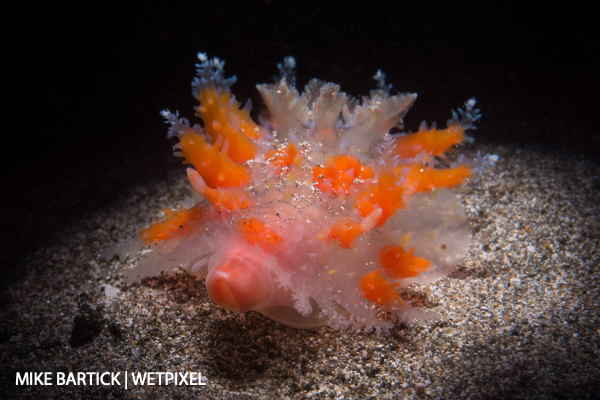
Kalinga ornata is a true a “lie and wait” predator. Lurking just below the sand with only the tips of their cerata exposed this slug is anything but sluggish.
Their prey (brittle stars) pass over them, unexpectedly alerting the ornates into action. The ornate suddenly emerges from the sand just behind them and quickly tracks them down snatching them up with quick vacuum action, just as quickly as it emerged it once again burrows down beneath the sand to wait for its next victim. Like a creature from the movie Dune. It makes me grateful that these guys are small.

Limenendra bernosii is a deeper dwelling nocturnal nudibranch that resembles a holiday candy in its coloration. The hunt for them is done exclusively with a dive plan that involves staying OFF the bottom and restricting fin kicks as they love silty bottoms. Searching quickly with only the light of a flashlight to guide you, finding them is very hit and miss.
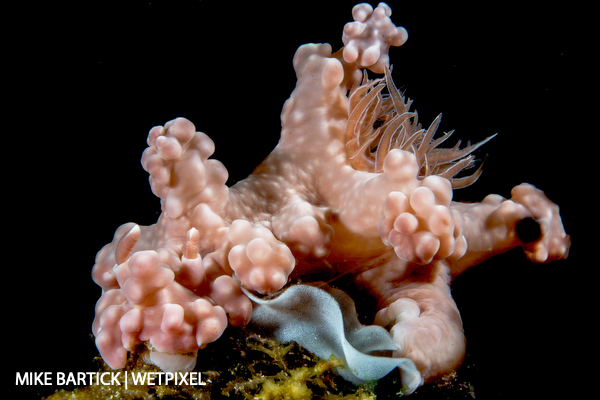
Miamira alleni is a recently renamed slug that resembles coral. The alleni can get huge, and we often refer to them as “Battleships.” They tend to be a longer living slug and are seen on habitats that range from algae bottoms to hard corals, walls and flat bottoms. Regular Anilao divers most often swim past them without ever realizing it, but once you learn how to find them, they nearly become common.

Melibe colemani. This slug is genuinely one of natures finest works. Extremely hard to find, the colemani exists on many of Anilao’s dive sites without anyone ever knowing it. Only after learning the right habitat and teaching my guides where to find them, were we able to find this remarkable creature. One observation we made sighted them as depth specific, more commonly found between 45 and 60 feet than anywhere else.
Resembling a ball of string, the developed muscle lines are opaque yet held together within a translucent tissue. A Melibe’s mouth opens like a massive fishing net when they cast it over the sand or soft corals to feed and/or drag themselves forward.
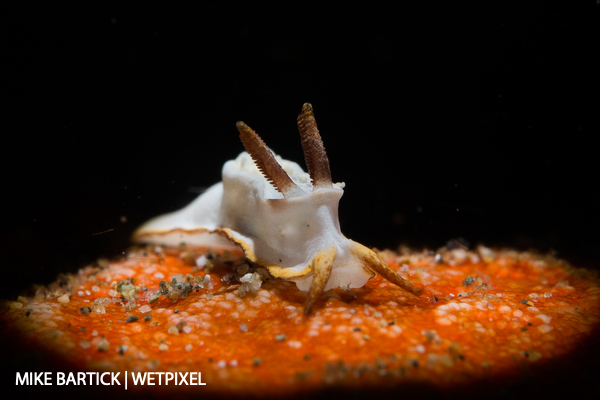
Goniodoris sp.7. Sometimes a speck of contrasting color will reveal something extraordinary. Occasionally specific types of slugs will quickly appear then disappear in rapid succession. Is this due to temperature, salinity, or available food? Only the data will determine the consistencies.

Thecacera sp. 6. Returning to the same dive site on a regular or daily basis will often reveal new finds. This Thecacera species is stunning to see and just as brightly colored without the strobe flash. Thacecera’s have fondly taken on the name “Pikachu” and feed primarily on individual hydroids just off the bottom.
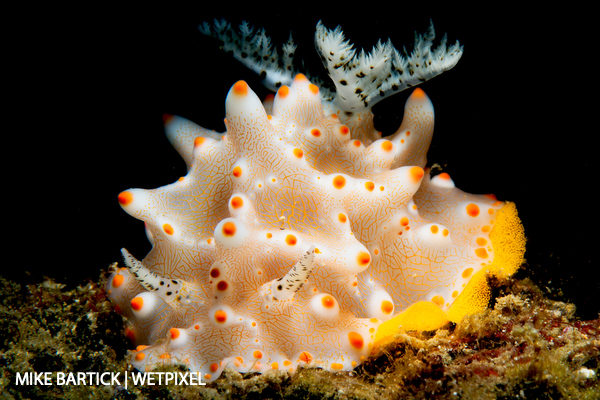
Halgerda batangas. The decorative spots along the foot are acid glands that release an offensive chemical potion when stressed. A fish will sometimes be seen biting a nudibranch or even eating them but what happens next is not pretty. The nudibranch releases its defensive chemicals, stinging or burning their would-be predator. The fish will eventually drown in its own saliva or die of starvation from the inflicted wounds.
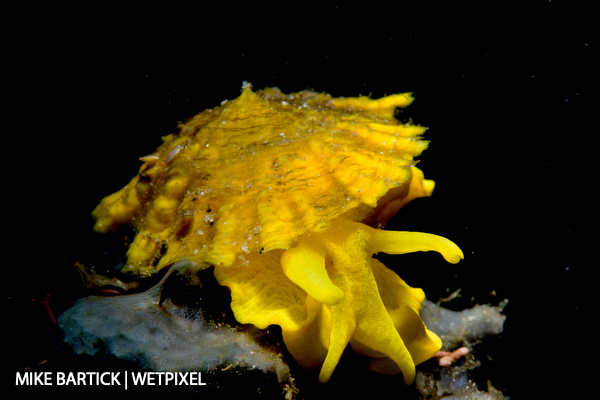
Tylodina. I was surprised and a bit confused when I found this bright yellow slug deep below a local wreck in our area. In Southern California, this guy is quite common and associated with sulfur sponges. However, upon closer examination, the shell is convoluted and wavy as opposed to its cold water causing that sports a smoother shell.
The results of the data produced from the two workshops have been added to the master species list for Anilao. A study conducted by the California Academy of Science and Terry Gosliner created the master list of running data over 10 years ago. Combined with Dr. Gosliner’s existing data, Anilao is now the world’s number one destination for nudibranch species diversity having surpassed the 1000 recorded species mark.
As it turned out our little workshops produced so much information in such a short period that it left us all surprised. Eager to repeat the process and to continue the hunt, dates have been set, and an annual event is now being created to celebrate our little friends with a festival.
Colorful, capable and slow, what better combination of things is there to celebrate!
About the author:
Mike Bartick of Saltwater Photo is a professional underwater photographer who is widely published and also manages the Crystal Blue Dive Resort in Anilao, Philippines.